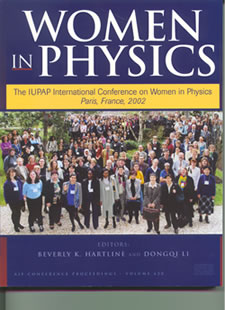|
|
Vol.
25 No. 2
March-April 2003
Women
in Physics
 Beverly
K. Hartline and Dongqi Li (editors) Beverly
K. Hartline and Dongqi Li (editors)
AIP Conference Proceedings, Volume 628, Melville, NY, 2002.
(ISBN
0-7354-0074-1)
It
takes women in some countries about 10 years longer than their
male colleagues to advance to the rank of professor. Societal
expectations and educational opportunities present barriers
in many countries to girls and women with talent for and interest
in physics. To develop strategies to improve this situation,
the first International Conference on Women in Physics brought
together more than 300 physicists–about 15% of them men–from
65 countries for three days of energizing and inspirational
presentations, discussion sessions, and informal interactions.
Organized by a working group of the International Union of
Pure and Applied Physics (IUPAP), the conference was held
at UNESCO headquarters in Paris from 7 to 9 March 2002. The
IUPAP Working Group on Women in Physics, established in 1999,
was charged to understand and to develop strategies for increasing
women’s participation in and impact on the field. It
is worth noting that the conference brought together physicists
from about 50% more countries than are represented in IUPAP.
The
proceedings make it possible for the conference to have impact
far beyond the participants. Readers will find in this volume
the welcoming remarks, survey report, invited presentations,
ideas and strategies from the discussions, resolutions, recommendations,
and wonderfully diverse contributions from the participating
countries.
Under
the leadership of Chairperson Marcia Barbosa (Brazil), the
Working Group initiated an international survey of women in
physics and organized the conference, inviting teams of physicists
from many countries to attend. Each team was asked to develop
a brief report and a poster on the situation of women in physics
in its country to share at the conference. Attendees heard
the results of the survey and received its preliminary written
report. Ten distinguished speakers –at least one from
every major geographic region–each provided insights
into her own experiences and described the situations, barriers,
and actions related to women in physics in her country. Participants
were welcomed by Philippe Busquin, Commissioner for Research
of the European Union; Walter Erdelen, Assistant Director-General
for Natural Sciences at UNESCO; and Burton Richter, President
of IUPAP. Discussions focused on issues and strategies related
to six important topics for increasing women’s involvement
in physics: attracting girls into physics, launching a successful
physics career, getting women into physics leadership, improving
the institutional climate, learning from regional differences,
and balancing family and career.
At
its final session, the conference unanimously adopted eight
resolutions directed at schools, universities, research institutes,
industries, scientific societies, national governments, granting
agencies, and IUPAP. These resolutions were presented and
endorsed at the 2002 IUPAP General Assembly in Berlin. In
addition, numerous recommendations were compiled that feature
specific actions or interventions, many of which have been
proven successful in one or more countries.
The
proceedings are available for free at <proceedings.
aip.org/proceedings/confproceed/628.jsp>. More
details on the conference can be found at the Web site below
under a link to the International Conference on Women in Physics.
www.iupap.org
Page last
modified 3 March 2003.
Copyright © 2002-2003 International Union of Pure and
Applied Chemistry.
Questions regarding the website, please contact [email protected]
|